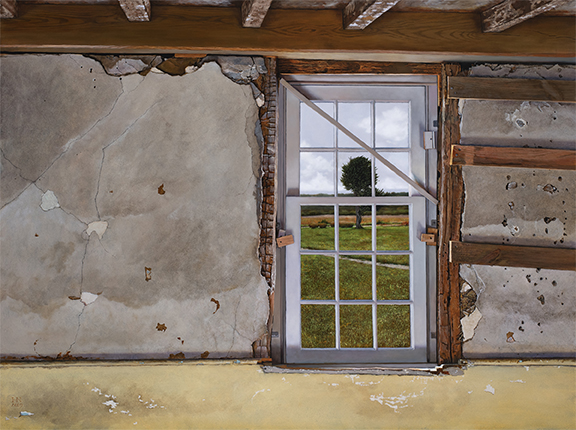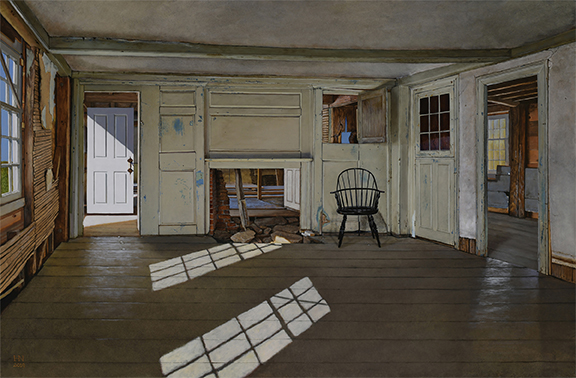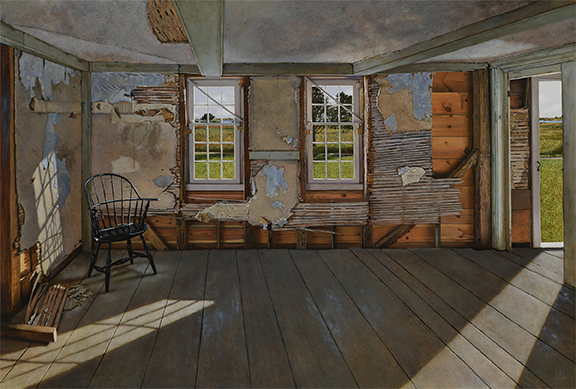An Interview with Heather Neill: Painting the Hancock-Mitchell House
Story by Kate Feiffer, Paintings by Heather Neill, oil on panel
I recently had an opportunity to sit down with artist Heather Neill at the Granary Gallery to interview her about the seven paintings she did of the Hancock-Mitchell house at Quansoo. The Hancock- Mitchell house, as most readers of this newsletter know, is considered to be either the second oldest, or oldest, house on Martha’s Vineyard and is being repaired and restored.
Neill was born in Hawaii, the daughter of a Presbyterian minister. She enrolled in Connecticut College in 1976 and says, “At that time there was zero expectation that you would make a living as an art major.” After graduation, she moved to Boston, and then to Pennsylvania, where she had also spent her high school years.
Neill was introduced to the Vineyard by Lynn Langmuir, a former Boston roommate. Lynn’s family had a house on Vineyard, and they’d come for weekends. We know how this story ends; a weekend on the Island so often results in a life-long habit. Neill and her wife, Pat Lackey, now try to spend as much time as they can on the Vineyard.
In 2001, after her first solo show in New York, Neill headed to the Vineyard for a weekend and showed her work to Chris Morse, owner of The Granary. Morse said, “We’ll take everything that didn’t sell.” Almost twenty years later, she’s still showing at the Granary. We sat and talked on a gray October morning in the back gallery space, where the few Hancock-Mitchell paintings that still haven’t sold are hung. The following interview has been edited for space and clarity.
Kate Feiffer: What inspired you to paint a series of painting of the Hancock-Mitchel house?
Heather Neill: The first inkling I had of the project was from an article in the Vineyard Gazette, so it was on my radar. Then the next article I saw, however weeks or months later, was when the house was under the tent and when I saw that piece I started to think, I want to get in there. How can I get in there? I’d like to see this? I was a woodworker, I am still, but I was actively a woodworker, doing Shaker style chairs. It was all green woodworking, so no power tools, so that era of construction is something that I already had an affinity for and a real curiosity about.

KF: What you chose to paint was not the obvious choice. Can you take us through your process?
HN: Adam Moore was gracious enough to say the door’s open, come anytime you want. This was a brand new space for me. I walk in, I know very little about it, and I came in the morning, in the middle of the day; I came at night when it was raining, when it was sunny, when there was a cloudy sky, a clear sky, just to get a sense of how the light moves through the space. I’m interested in what are the first things that I see that I can’t wait to get my teeth into, and one of them was the idea that this was and is a study house, so there are places where they’ve worn the paint down deliberately to find out what’s underneath, revealing these layers of history. I see my job as how to tell a complete story about this space.
I started painting this series two years after I was first there. I was fully expecting to come home and begin working on this project but several things got in the way for whatever reason, and every time I went back to look at the thousands of photographs that I took—
KF: Did you say you took thousands of photographs?
HN: Thousands, twenty thousand. Because I’m not a photographer, I’ll photograph every single inch and every single depth, so I bring home all the reference I need, because with this kind of detail, I want to have an accurate representation. But it didn’t click that first year, so it percolated a little bit. I came back again and looked at it, and thought —now I’m in. I’ve got this.
KF: I love the interplay between the dilapidated interior and this beautiful lush exterior in the painting.
HN: I intended to do a large painting from the front door looking out, so you get that wonderful vista and I stopped midway and thought, Okay, I’ll pull back and have the landscapes be through these little glimpses out the windows. It almost felt overwhelming to try to paint that vista and putting it in a nice little box, I hope it gave the sense of walking out there, there’s something broad and vast.
Wattle and daub is as close to of-the-landscape you can get in a building material. You’re literally going out, getting the mud, getting the seaweed, getting the straw, using
it give you shelter.
KF: I’m curious about how a place changes for you when you paint it in this kind of
detail, how your relationship with the place you are painting changes and evolves?
 HN: When I start painting a place, I don’t know it yet. But when I sit down and I blow up a photograph here, I really have to know (Neill points at one of the paintings) how that molding is going to transition here, then I have to come to understand, where was that floor line for 200 years, now that it’s revealed. I know something about how to build things, because I’ve done that, so I understand that you had to start out square, and now that it’s cattywampus, it’s settled and something has changed, but I now know that intimately because I have chosen to get into the pores and so I walk away now and feel like I have learned at a cellular level what was in that space and how it was built.
HN: When I start painting a place, I don’t know it yet. But when I sit down and I blow up a photograph here, I really have to know (Neill points at one of the paintings) how that molding is going to transition here, then I have to come to understand, where was that floor line for 200 years, now that it’s revealed. I know something about how to build things, because I’ve done that, so I understand that you had to start out square, and now that it’s cattywampus, it’s settled and something has changed, but I now know that intimately because I have chosen to get into the pores and so I walk away now and feel like I have learned at a cellular level what was in that space and how it was built.


